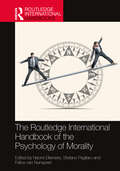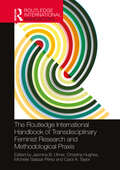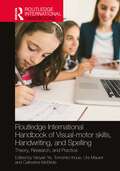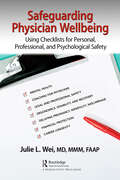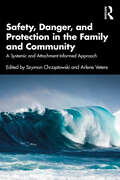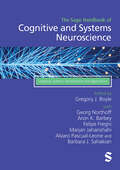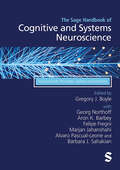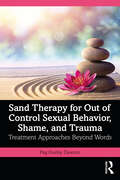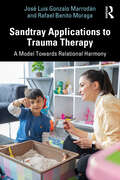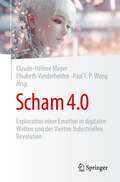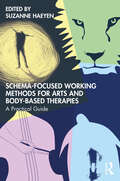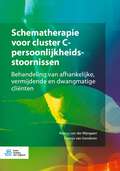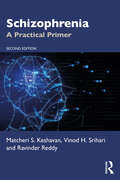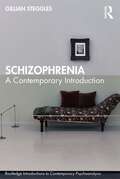- Table View
- List View
The Routledge International Handbook of the Psychology of Morality (Routledge International Handbooks)
by Naomi Ellemers Stefano Pagliaro Félice Van NunspeetThis cutting-edge handbook examines moral psychology and behavior, uncovering layers of human morality through a comprehensive overview of topics and approaches. Featuring an array of expert international contributors, the book addresses five key themes: moral reasoning, moral judgments, moral emotions, moral behavior and moral self-views. Each section includes empirical chapters that address these themes at the intrapersonal, interpersonal, intragroup or intergroup level. Each section starts with a reflective chapter from a leading scholar in this field of study who shares their personal vision on key issues and future developments. Drawing on emerging research and featuring real-world examples, the book offers a deeper understanding of the social psychological factors that shape our moral behavior and how this plays out in our daily lives. The Routledge International Handbook of the Psychology of Morality will be essential reading for academics and students in social psychology, the psychology of morality, business ethics and related areas. It will also be a compelling resource for legal and HR professionals, policy makers and anyone interested in understanding the complex and multi-faceted nature of human morality.
The Routledge International Handbook of Transdisciplinary Feminist Research and Methodological Praxis
by Jasmine B. Ulmer Christina Hughes Michelle Salazar Pérez Carol A. TaylorThe Routledge International Handbook of Transdisciplinary Feminist Research and Methodological Praxis is organized around ways of doing fair and just research, with deliberate transdisciplinary overlap in each of the sections so as to share and demonstrate potential opportunities for lasting alliances.Authors and artists address topics that include the doing of original transdisciplinary research and engaging multiple communities in research; mentoring from both academic and community-based perspectives; creating and maintaining collaborative relationships; managing personal, professional, and financial challenges; addressing writing blocks and feelings of being overwhelmed; and experiences of care and joy. The range of feminist work invoked in this volume include, but are not limited to: intersectional feminisms, abolitionist feminism, Black feminism, Womanism, Chicana feminism, Latina feminism, BIPOC feminisms, Indigenous feminism, decolonial and postcolonial feminism, transnational feminism, gender and sexuality studies, queer feminism, trans feminisms, poststructural feminism, posthuman and more-than-human feminism, materialist feminism, crip feminism, feminist disability studies, quantum feminism, sonic feminisms, feminist science studies, science and technology studies, or STS, and more.From advanced graduate students to seasoned scholars, this volume presents timely knowledge and will be useful as a substantive guide to round out understandings of multiple approaches to feminist research.
The Routledge International Handbook of Transdisciplinary Feminist Research and Methodological Praxis
The Routledge International Handbook of Transdisciplinary Feminist Research and Methodological Praxis is organized around ways of doing fair and just research, with deliberate transdisciplinary overlap in each of the sections so as to share and demonstrate potential opportunities for lasting alliances.Authors and artists address topics that include the doing of original transdisciplinary research and engaging multiple communities in research; mentoring from both academic and community-based perspectives; creating and maintaining collaborative relationships; managing personal, professional, and financial challenges; addressing writing blocks and feelings of being overwhelmed; and experiences of care and joy. The range of feminist work invoked in this volume include, but are not limited to: intersectional feminisms, abolitionist feminism, Black feminism, Womanism, Chicana feminism, Latina feminism, BIPOC feminisms, Indigenous feminism, decolonial and postcolonial feminism, transnational feminism, gender and sexuality studies, queer feminism, trans feminisms, poststructural feminism, posthuman and more-than-human feminism, materialist feminism, crip feminism, feminist disability studies, quantum feminism, sonic feminisms, feminist science studies, science and technology studies, or STS, and more.From advanced graduate students to seasoned scholars, this volume presents timely knowledge and will be useful as a substantive guide to round out understandings of multiple approaches to feminist research.
Routledge International Handbook of Visual-motor skills, Handwriting, and Spelling: Theory, Research, and Practice (Routledge International Handbooks)
by Yanyan Ye Tomohiro Inoue Urs Maurer Catherine McBrideThe Routledge International Handbook of Visual-motor skills, Handwriting, and Spelling explores the potentially controversial field of early literacy education. It aims to offer scholars and practitioners an analysis of how and why handwriting skills benefit early literacy learning, especially spelling acquisition, and how this can enrich experiences for children and educators. Offering global perspectives from the field, the volume integrates current theories with up-to-date research and practice, revealing how we can best support children’s early literacy learning with handwriting and visual-motor skills interventions. Key topics covered include: The fundamentals of handwriting skills and literacy acquisition; Global literacy and spelling; Dysgraphia, handwriting difficulties, and dyslexia; Spelling and writing in the digital age; Home learning environment and spelling; Instruction and interventions for spelling and writing. This comprehensive survey will be essential reading for scholars and students of developmental psychology, education, and literacy research.
Routledge International Handbook of Visual-motor skills, Handwriting, and Spelling: Theory, Research, and Practice (Routledge International Handbooks)
by Yanyan Ye Tomohiro Inoue Urs Maurer Catherine McBrideThe Routledge International Handbook of Visual-motor skills, Handwriting, and Spelling explores the potentially controversial field of early literacy education. It aims to offer scholars and practitioners an analysis of how and why handwriting skills benefit early literacy learning, especially spelling acquisition, and how this can enrich experiences for children and educators. Offering global perspectives from the field, the volume integrates current theories with up-to-date research and practice, revealing how we can best support children’s early literacy learning with handwriting and visual-motor skills interventions. Key topics covered include: The fundamentals of handwriting skills and literacy acquisition; Global literacy and spelling; Dysgraphia, handwriting difficulties, and dyslexia; Spelling and writing in the digital age; Home learning environment and spelling; Instruction and interventions for spelling and writing. This comprehensive survey will be essential reading for scholars and students of developmental psychology, education, and literacy research.
Safeguarding Physician Wellbeing: Using Checklists for Personal, Professional, and Psychological Safety
by Julie L. WeiThe United States is facing a worsening epidemic of physician burnout with unprecedented numbers of them leaving the workforce and practice of clinical medicine across all career stages. The prevalence of physician burnout has accelerated through COVID-19, resulting in an anticipated serious national shortage of physicians within the current decade amidst an increased proportion of aging and unhealthy population. The critical shortage of physicians coupled with an unhealthy physician workforce results in longer wait times for access, continued increased healthcare costs, decreased quality of care, and worsening patient experience. Despite increasing media coverage, published data, and identification of system-based factors that erode physician wellbeing, no standardized systematic solution has been implemented across hospitals, health systems, or a variety of employment models or practice settings for any or all doctors regardless of whether they are primary care, medical, or surgical subspecialists. Effective solutions to mitigate physician burnout, protect current working physicians, and keep them from leaving medicine require a SHIFT and a more individualized approach. Many proposed academic models address system-based factors, but such solutions depend greatly on those who employ doctors. Executive leadership in charge of healthcare systems are often challenged by physician burnout and their desired autonomy, against the need for standardization of care delivery to improve quality and decrease cost. Physician productivity measures continue to be based on data samples of physician compensation surveys supplied by companies like Sullivan Cotter or Medical Group Management Association (MGMA). Such benchmarks are commonly used but data may not reflect specific realities for any organizations nor the rapid changes in the landscape of US healthcare amidst mergers, acquisitions, consolidation, and shifts in employment models from insurance and online retail giants and private equity. This book uses a "checklist" approach to empower any medical student, resident, fellow, or practicing physician to create and experience psychological, personal, and professional safety and wellbeing. Not only can individual physicians choose and use these checklists themselves, but those who live with, love, and cherish one or more physicians in their families and/or lives can use this book to understand physician realities and their risks.
Safeguarding Physician Wellbeing: Using Checklists for Personal, Professional, and Psychological Safety
by Julie L. WeiThe United States is facing a worsening epidemic of physician burnout with unprecedented numbers of them leaving the workforce and practice of clinical medicine across all career stages. The prevalence of physician burnout has accelerated through COVID-19, resulting in an anticipated serious national shortage of physicians within the current decade amidst an increased proportion of aging and unhealthy population. The critical shortage of physicians coupled with an unhealthy physician workforce results in longer wait times for access, continued increased healthcare costs, decreased quality of care, and worsening patient experience. Despite increasing media coverage, published data, and identification of system-based factors that erode physician wellbeing, no standardized systematic solution has been implemented across hospitals, health systems, or a variety of employment models or practice settings for any or all doctors regardless of whether they are primary care, medical, or surgical subspecialists. Effective solutions to mitigate physician burnout, protect current working physicians, and keep them from leaving medicine require a SHIFT and a more individualized approach. Many proposed academic models address system-based factors, but such solutions depend greatly on those who employ doctors. Executive leadership in charge of healthcare systems are often challenged by physician burnout and their desired autonomy, against the need for standardization of care delivery to improve quality and decrease cost. Physician productivity measures continue to be based on data samples of physician compensation surveys supplied by companies like Sullivan Cotter or Medical Group Management Association (MGMA). Such benchmarks are commonly used but data may not reflect specific realities for any organizations nor the rapid changes in the landscape of US healthcare amidst mergers, acquisitions, consolidation, and shifts in employment models from insurance and online retail giants and private equity. This book uses a "checklist" approach to empower any medical student, resident, fellow, or practicing physician to create and experience psychological, personal, and professional safety and wellbeing. Not only can individual physicians choose and use these checklists themselves, but those who live with, love, and cherish one or more physicians in their families and/or lives can use this book to understand physician realities and their risks.
Safety, Danger, and Protection in the Family and Community: A Systemic and Attachment-Informed Approach
by Szymon Chrząstowski Arlene VetereThis book provides an analysis of the meaning of safety and security across the contexts of community and public life, throughout the life span, and within a therapeutic framework, examining threats and the strategies for coping with them. The book starts in Part I with a discussion of general safety and security concepts in the socio-cultural context. Part II of the book details the role of a sense of security in psychological assistance, psychotherapy and supervision, while Part III centres on safety and security at different life stages. Drawing on the tenets of modern attachment theory and trauma theory, chapter authors address questions of safety, danger, and protection for both individuals and groups, across a variety of fields of knowledge and expertise. Themes such as loneliness, play and exploration, evil and forgiveness, health and death, and spirituality and healing are discussed as practice examples, learning points, and tips. A wide range of health and social care professional practitioners will find this book useful in exploring social, interpersonal, and psychological aspects of safety and security.
Safety, Danger, and Protection in the Family and Community: A Systemic and Attachment-Informed Approach
This book provides an analysis of the meaning of safety and security across the contexts of community and public life, throughout the life span, and within a therapeutic framework, examining threats and the strategies for coping with them. The book starts in Part I with a discussion of general safety and security concepts in the socio-cultural context. Part II of the book details the role of a sense of security in psychological assistance, psychotherapy and supervision, while Part III centres on safety and security at different life stages. Drawing on the tenets of modern attachment theory and trauma theory, chapter authors address questions of safety, danger, and protection for both individuals and groups, across a variety of fields of knowledge and expertise. Themes such as loneliness, play and exploration, evil and forgiveness, health and death, and spirituality and healing are discussed as practice examples, learning points, and tips. A wide range of health and social care professional practitioners will find this book useful in exploring social, interpersonal, and psychological aspects of safety and security.
The Sage Handbook of Cognitive and Systems Neuroscience: Cognitive Systems, Development and Applications
Cognitive neuroscience is the interdisciplinary study of how cognitive and intellectual functions are processed and represented within the brain, which is critical to building understanding of core psychological and behavioural processes such as learning, memory, behaviour, perception, and consciousness. Understanding these processes not only offers relevant fundamental insights into brain-behavioural relations, but may also lead to actionable knowledge that can be applied in the clinical treatment of patients with various brain-related disabilities. This Handbook examines complex cognitive systems through the lens of neuroscience, as well as providing an overview of development and applications within cognitive and systems neuroscience research and beyond. Containing 35 original, state of the art contributions from leading experts in the field, this Handbook is essential reading for researchers and students of cognitive psychology, as well as scholars across the fields of neuroscientific, behavioural and health sciences. Part 1: Attention, Learning and Memory Part 2: Language and Communication Part 3: Emotion and Motivation Part 4: Social Cognition Part 5: Cognitive Control and Decision Making Part 6: Intelligence
The Sage Handbook of Cognitive and Systems Neuroscience: Neuroscientific Principles, Systems and Methods
Cognitive neuroscience is the interdisciplinary study of how cognitive and intellectual functions are processed and represented within the brain, which is critical to building understanding of core psychological and behavioural processes such as learning, memory, behaviour, perception, and consciousness. Understanding these processes not only offers relevant fundamental insights into brain-behavioural relations, but may also lead to actionable knowledge that can be applied in the clinical treatment of patients with various brain-related disabilities. This Handbook focusses on the foundational principles, methods, and underlying systems in cognitive and systems neuroscience, as well as examining cutting-edge methodological advances and innovations. Containing 34 original, state of the art contributions from leading experts in the field, this Handbook is essential reading for researchers and students of cognitive psychology, as well as scholars across the fields of neuroscientific, behavioural and health sciences. Part 1: Background Considerations Part 2: Neuroscientific Substrates and Principles Part 3: Neuroanatomical Brain Systems Part 4: Neural Dynamics and Processes Part 5: Sensory-Perceptual Systems and Cognition Part 6: Methodological Advances
The Sage Handbook of Cognitive and Systems Neuroscience: Neuroscientific Principles, Systems and Methods
by Gregory J. Boyle Georg Northoff Aron K. Barbey Felipe Fregni Marjan Jahanshahi Alvaro Pascual-Leone Barbara J. SahakianCognitive neuroscience is the interdisciplinary study of how cognitive and intellectual functions are processed and represented within the brain, which is critical to building understanding of core psychological and behavioural processes such as learning, memory, behaviour, perception, and consciousness. Understanding these processes not only offers relevant fundamental insights into brain-behavioural relations, but may also lead to actionable knowledge that can be applied in the clinical treatment of patients with various brain-related disabilities. This Handbook focusses on the foundational principles, methods, and underlying systems in cognitive and systems neuroscience, as well as examining cutting-edge methodological advances and innovations. Containing 34 original, state of the art contributions from leading experts in the field, this Handbook is essential reading for researchers and students of cognitive psychology, as well as scholars across the fields of neuroscientific, behavioural and health sciences. Part 1: Background Considerations Part 2: Neuroscientific Substrates and Principles Part 3: Neuroanatomical Brain Systems Part 4: Neural Dynamics and Processes Part 5: Sensory-Perceptual Systems and Cognition Part 6: Methodological Advances
The Sage Handbook of Cognitive and Systems Neuroscience: Neuroscientific Principles, Systems and Methods
by Gregory J. Boyle Georg Northoff Aron K. Barbey Felipe Fregni Marjan Jahanshahi Alvaro Pascual-Leone Barbara J. SahakianCognitive neuroscience is the interdisciplinary study of how cognitive and intellectual functions are processed and represented within the brain, which is critical to building understanding of core psychological and behavioural processes such as learning, memory, behaviour, perception, and consciousness. Understanding these processes not only offers relevant fundamental insights into brain-behavioural relations, but may also lead to actionable knowledge that can be applied in the clinical treatment of patients with various brain-related disabilities. This Handbook focusses on the foundational principles, methods, and underlying systems in cognitive and systems neuroscience, as well as examining cutting-edge methodological advances and innovations. Containing 34 original, state of the art contributions from leading experts in the field, this Handbook is essential reading for researchers and students of cognitive psychology, as well as scholars across the fields of neuroscientific, behavioural and health sciences. Part 1: Background Considerations Part 2: Neuroscientific Substrates and Principles Part 3: Neuroanatomical Brain Systems Part 4: Neural Dynamics and Processes Part 5: Sensory-Perceptual Systems and Cognition Part 6: Methodological Advances
The Sage Handbook of Cognitive and Systems Neuroscience: Cognitive Systems, Development and Applications
by Gregory J. Boyle Georg Northoff Aron K. Barbey Felipe Fregni Marjan Jahanshahi Alvaro Pascual-Leone Barbara J. SahakianCognitive neuroscience is the interdisciplinary study of how cognitive and intellectual functions are processed and represented within the brain, which is critical to building understanding of core psychological and behavioural processes such as learning, memory, behaviour, perception, and consciousness. Understanding these processes not only offers relevant fundamental insights into brain-behavioural relations, but may also lead to actionable knowledge that can be applied in the clinical treatment of patients with various brain-related disabilities. This Handbook examines complex cognitive systems through the lens of neuroscience, as well as providing an overview of development and applications within cognitive and systems neuroscience research and beyond. Containing 35 original, state of the art contributions from leading experts in the field, this Handbook is essential reading for researchers and students of cognitive psychology, as well as scholars across the fields of neuroscientific, behavioural and health sciences. Part 1: Attention, Learning and Memory Part 2: Language and Communication Part 3: Emotion and Motivation Part 4: Social Cognition Part 5: Cognitive Control and Decision Making Part 6: Intelligence
The Sage Handbook of Cognitive and Systems Neuroscience: Cognitive Systems, Development and Applications
by Gregory J. Boyle Georg Northoff Aron K. Barbey Felipe Fregni Marjan Jahanshahi Alvaro Pascual-Leone Barbara J. SahakianCognitive neuroscience is the interdisciplinary study of how cognitive and intellectual functions are processed and represented within the brain, which is critical to building understanding of core psychological and behavioural processes such as learning, memory, behaviour, perception, and consciousness. Understanding these processes not only offers relevant fundamental insights into brain-behavioural relations, but may also lead to actionable knowledge that can be applied in the clinical treatment of patients with various brain-related disabilities. This Handbook examines complex cognitive systems through the lens of neuroscience, as well as providing an overview of development and applications within cognitive and systems neuroscience research and beyond. Containing 35 original, state of the art contributions from leading experts in the field, this Handbook is essential reading for researchers and students of cognitive psychology, as well as scholars across the fields of neuroscientific, behavioural and health sciences. Part 1: Attention, Learning and Memory Part 2: Language and Communication Part 3: Emotion and Motivation Part 4: Social Cognition Part 5: Cognitive Control and Decision Making Part 6: Intelligence
Sand Therapy for Out of Control Sexual Behavior, Shame, and Trauma: Treatment Approaches Beyond Words
by Peg Hurley DawsonThis book is designed to educate sex therapists and mental health professionals on the power of using sand when treating sexual issues, providing guidance in accessing their clients’ unconscious to seek new ways of healing. Uniquely integrating sex therapy with sand therapy, Dawson describes how understanding and applying non-pathological theories and neuroscience to different modalities, such as Internal Family Systems and Polyvagal Theory, can help clients move forward from shame, sexual dysfunctions, and trauma. The book begins by introducing how therapists can use sand as a doorway into using metaphor and imagery in their practice, with information on how the nervous system keeps somatic experiences trapped in the body being explored. Written in an easy, accessible style, the book also includes handouts, belief cards, and case studies throughout to help therapists see the benefits of using sand with clients in practice. Including forewords by Dr. Lorraine Freedle and Doug Braun-Harvey, this book is geared toward mental health professionals, such as sex therapists and marriage and family therapists, who are working with individuals and couples seeking treatment from complex trauma and mental and sexual health issues. It will appeal to students as well as advanced mental health clinicians looking to expand their therapeutic tool kit.
Sand Therapy for Out of Control Sexual Behavior, Shame, and Trauma: Treatment Approaches Beyond Words
by Peg Hurley DawsonThis book is designed to educate sex therapists and mental health professionals on the power of using sand when treating sexual issues, providing guidance in accessing their clients’ unconscious to seek new ways of healing. Uniquely integrating sex therapy with sand therapy, Dawson describes how understanding and applying non-pathological theories and neuroscience to different modalities, such as Internal Family Systems and Polyvagal Theory, can help clients move forward from shame, sexual dysfunctions, and trauma. The book begins by introducing how therapists can use sand as a doorway into using metaphor and imagery in their practice, with information on how the nervous system keeps somatic experiences trapped in the body being explored. Written in an easy, accessible style, the book also includes handouts, belief cards, and case studies throughout to help therapists see the benefits of using sand with clients in practice. Including forewords by Dr. Lorraine Freedle and Doug Braun-Harvey, this book is geared toward mental health professionals, such as sex therapists and marriage and family therapists, who are working with individuals and couples seeking treatment from complex trauma and mental and sexual health issues. It will appeal to students as well as advanced mental health clinicians looking to expand their therapeutic tool kit.
Sandtray Applications to Trauma Therapy: A Model Towards Relational Harmony
by José Luis Marrodán Rafael Benito MoragaSandtray Applications to Trauma Therapy presents the theory behind and the practicalities of using sandtray therapy in treatment with traumatized patients, both children and adults. The book begins with a review of the most frequently asked questions that professionals ask themselves when using the sandtray. It then details the Barudy and Dantagnan model of trauma therapy to understand and integrate sandtray therapy with patients who have suffered trauma. Chapters describe the importance of neuroaffective communication, directive and non-directive working methodologies, and how to use the technique in regulation, empowerment, and resilient integration of trauma. A featured chapter by the second author, Dr. Raffael Benito, presents the neurobiology behind sandtray therapy, outlining step by step what happens in the brain of a patient during a sandtray session. Transcripts of clinical cases, sandtray images, and true client stories are integrated throughout. This practical volume will appeal to sandtray practitioners, trauma therapists, psychologists, and psychiatrists working with patient experiences of abandonment, mistreatment, or sexual abuse, among others.
Sandtray Applications to Trauma Therapy: A Model Towards Relational Harmony
by José Luis Marrodán Rafael Benito MoragaSandtray Applications to Trauma Therapy presents the theory behind and the practicalities of using sandtray therapy in treatment with traumatized patients, both children and adults. The book begins with a review of the most frequently asked questions that professionals ask themselves when using the sandtray. It then details the Barudy and Dantagnan model of trauma therapy to understand and integrate sandtray therapy with patients who have suffered trauma. Chapters describe the importance of neuroaffective communication, directive and non-directive working methodologies, and how to use the technique in regulation, empowerment, and resilient integration of trauma. A featured chapter by the second author, Dr. Raffael Benito, presents the neurobiology behind sandtray therapy, outlining step by step what happens in the brain of a patient during a sandtray session. Transcripts of clinical cases, sandtray images, and true client stories are integrated throughout. This practical volume will appeal to sandtray practitioners, trauma therapists, psychologists, and psychiatrists working with patient experiences of abandonment, mistreatment, or sexual abuse, among others.
Scham 4.0: Exploration einer Emotion in digitalen Welten und der Vierten Industriellen Revolution
by Elisabeth Vanderheiden Claude-Hélène Mayer Paul T. P. WongDieser Sammelband bietet neue Perspektiven darauf, wie das Gefühl Scham in digitalen Welten und in der Industrie 4.0 erlebt und verändert wird. Die Herausgeber*innen und Autor*innen diskutieren, wie Individuen und Organisationen Scham am Arbeitsplatz, in beruflichen und privaten Kontexten und im Hinblick auf soziokulturelle Lebensstilveränderungen konstruktiv transformieren können. Die Beiträge in diesem Band ermöglichen es Forscher*innen und Praktiker*innen gleichermaßen, das Thema Scham und seine Spezifika in einer hochdynamischen und sich schnell verändernden Zeit zu erschließen. Das Verständnis für diese Emotion im Zusammenhang mit Home Office, automatisierten Realitäten und smarten Systemen oder digitalisierten Lebens- und Arbeitsstilen wird vertieft. Durch den Einsatz transdisziplinärer und transkultureller Perspektiven erörtert der Band darüber hinaus Scham im Kontext neuer Lebensstile, Religion, Geschlecht, sexueller Unterdrückung und psychischer Erkrankungen. Forscher*innen, Praktiker*innen und Studierende aus den Bereichen Arbeits- und Organisationspsychologie, Positive Psychologie, Organisationsforschung, Zukunftsforschung, Gesundheits- und Arbeitswissenschaft, Therapie und Beratung, Emotionswissenschaften, Management, Führung und Personalwesen werden die Beiträge als hochaktuell, aufschlussreich und praxisrelevant empfinden.
Schema-Focused Working Methods for Arts and Body-Based Therapies
by Suzanne HaeyenThis book introduces schema-focused working methods for arts and body-based therapies, offering therapists practice-based tools to help their clients strengthen healthy patterns, self-management, and well-being on their path to recovery.Containing 158 schema-focused working methods for different arts and body-based therapies, such as art therapy, dance therapy, drama therapy, music therapy, and body-based or psychomotor therapy, this book offers new ideas and tools for therapists to strengthen their client’s adaptive schema modes: the Healthy Adult and the Happy Child. By linking arts and body-based therapies to schema-focused therapy and positive psychology, the goal is to strengthen the client’s healthy patterns in emotion regulation and establish a healthier well-being.The theoretical framework in the introduction and the scientific evidence for arts and psychomotor therapies, combined with the practice-based examples, allow for a text that is broad enough for graduate creative therapy programs and specific enough to serve as a shelf reference for those in practice.
Schema-Focused Working Methods for Arts and Body-Based Therapies
This book introduces schema-focused working methods for arts and body-based therapies, offering therapists practice-based tools to help their clients strengthen healthy patterns, self-management, and well-being on their path to recovery.Containing 158 schema-focused working methods for different arts and body-based therapies, such as art therapy, dance therapy, drama therapy, music therapy, and body-based or psychomotor therapy, this book offers new ideas and tools for therapists to strengthen their client’s adaptive schema modes: the Healthy Adult and the Happy Child. By linking arts and body-based therapies to schema-focused therapy and positive psychology, the goal is to strengthen the client’s healthy patterns in emotion regulation and establish a healthier well-being.The theoretical framework in the introduction and the scientific evidence for arts and psychomotor therapies, combined with the practice-based examples, allow for a text that is broad enough for graduate creative therapy programs and specific enough to serve as a shelf reference for those in practice.
Schematherapie voor cluster C-persoonlijkheidsstoornissen: Behandeling van afhankelijke, vermijdende en dwangmatige cliënten
by Remco van der Wijngaart Hannie van GenderenDit boek helpt therapeuten om schematherapie toe te passen bij cliënten met afhankelijke, vermijdende of dwangmatige persoonlijkheidsstoornissen, ook wel cluster C-persoonlijkheidsstoornissen genoemd. Schematherapie is een zeer effectieve behandelmethode voor cluster C-stoornissen. De meeste literatuur en trainingen op het gebied van schematherapie richten zich echter op de behandeling van de borderline persoonlijkheidsstoornis of andere vormen van externaliserende problematiek. Dit boek laat zien hoe schematherapie effectief toepasbaar is bij internaliserende persoonlijkheidsproblematiek. Schematherapie voor cluster C-persoonlijkheidsstoornissen - Behandeling van afhankelijke, vermijdende en dwangmatige cliënten beschrijft hoe cluster C-stoornissen begrepen kunnen worden in termen van basisbehoeften, schema’s en modi. Daarnaast wordt ook beschreven hoe limited reparenting op een andere manier vormgegeven wordt in deze behandeling dan bij meer externaliserende problematiek. Ten slotte worden specifieke knelpunten, varianten en toepassingen van methoden en technieken beschreven die nog niet terug te vinden zijn in andere literatuur over schematherapie. Het boek begint met een beschrijving van onder meer geschiedenis en onderzoek. Daarna gaat het in op casusconceptualisatie en de stap van conceptualisatie naar behandeling. Vervolgens behandelt het de verschillende persoonlijkheidsstoornissen waarbij steeds beschreven wordt hoe methoden en technieken anders toegepast worden in de verschillende behandelfasen. Ten slotte gaat het in op methoden om de gezonde volwassene te versterken en de therapieresultaten in de toekomst te behouden. Het boek bevat veel aansprekende casuïstiek. De auteurs zijn psychotherapeut en gz-psycholoog Remco van der Wijngaart, en klinisch psycholoog Hannie van Genderen.
Schizophrenia: A Practical Primer
by Matcheri S. Keshavan Vinod Srihari Ravinder ReddyThis second edition of Schizophrenia: A Practical Primer, includes decades of clinical and research experience in the field and helps readers understand what schizophrenia is and how it is managed.Schizophrenia is a devastating illness that affects more than 50 million people worldwide. Written to help anyone who is faced with managing schizophrenia, whether as a clinician, patient, friend, or family member, this accessible book is an ideal first stop for practical, up-to-date information. It includes an overview of schizophrenia and provides answers to common questions that arise on different aspects of the illness, such as: diagnosis, pharmacological and psychotherapeutic management, treatment challenges and achieving recovery. Beyond these key issues, the book includes developments in the neurobiology of the illness, foreseeable developments and the history of schizophrenia. It also includes brief, realistic case vignettes adapted from clinical experience, and questions interspersed throughout the book to aid understanding.This book is essential for professional trainee and early-career mental-health workers, such as psychiatrists, psychologists, social workers, counselors and nurses, and is written to cover in a concise and accessible way what is of immediate and practical relevance to gain familiarity with schizophrenia.
Schizophrenia: A Contemporary Introduction (Routledge Introductions to Contemporary Psychoanalysis)
by Gillian StegglesSchizophrenia: A Contemporary Introduction provides a vital overview of psychoanalytic work with patients dealing with schizophrenia, highlighting the many benefits of this approach and introducing key methods for mental health practitioners.This concise introductory volume starts by offering a brief historical introduction to how psychoanalysts, from Freud onwards, have approached schizophrenia and the methods they have used to alleviate the distress it causes its sufferers. Gillian Steggles illustrates how the developing relationship between patient and analyst can positively impact the patient’s mental functioning, leading to an improvement in their overall health and the ability to regain independence and self-reliance. She introduces theoretical psychoanalytic approaches, such as the Psychodynamic Pentapointed Cognitive Construct (PPCC) model, as a means of offering guidance to analysts dealing with schizophrenic analysands.This book will be of interest to practicing and trainee analysts, as well as those interested in the history of schizophrenia and its continued impact.
